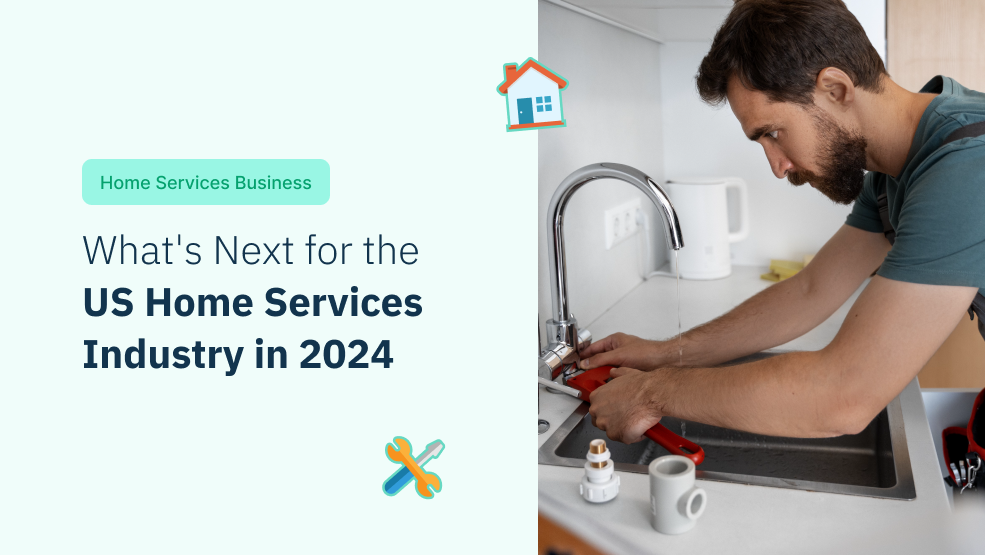Projected to surpass $657 billion by 2024, the US home services industry is on the brink of monumental growth. This expansion is a testament to how much you, the consumer, rely on these indispensable services—from routine maintenance to emergency repairs. With in-home services evolving, the convenience and efficiency of on-demand services are reshaping expectations and setting new standards across the board. This surge is not just about numbers—it’s about the significant transformation impacting how services are delivered and experienced in homes across America.
Rise of on-demand home services
The US home services industry is undergoing a significant transformation, primarily fueled by the rise of on-demand home services. This segment is not only growing—it’s revolutionizing how services are delivered to your doorstep. Here’s a closer look at the key trends and statistics shaping this dynamic sector.
Expanding market size and growth projections
The on-demand home services market is witnessing robust growth, with projections indicating a continuous upward trajectory. As of the 2021 report, the US home services industry was poised to reach a market size of USD 5.14 trillion by 2026, growing at a staggering annual growth rate (CAGR) of 36.21%. This growth is mirrored globally, with the online on-demand home services market expected to surge from USD 3.71 billion in 2021 to USD 14.7 billion by 2030.
Diverse services and increasing demand
The array of services offered through on-demand platforms has significantly diversified. Specialized offerings, including high-tech repairs and eco-friendly solutions, now complement traditional services such as cleaning and maintenance. Notably, as per a report, cleaning services are anticipated to grow by 20% annually, with an estimated 80% of US households likely to use such services by 2024
Technological innovations and consumer preferences
Key trends driving this market include the integration of mobile apps and digital platforms, smart home technologies, and changing consumer lifestyles that prioritize convenience. Over 80% of home service businesses have adopted digital tools for scheduling and customer management, a 150% increase from pre-pandemic levels. This digital shift is largely due to the rising consumer preference for convenience and the growing usage of smartphones.
Market leaders and competitive landscape
The on-demand home services market is a competitive field vying for dominance through constant innovation. North America, particularly the United States, plays a crucial role in the global market, with significant growth expected soon. Surging growth reflects shifting market dynamics and how consumer behavior and technology are reshaping the home services industry.
Technological innovation and smart home integration
Technology in home services has been changing since the decade. What we can expect in the upcoming years is the digital platforms, smart home technological integration, and eco-friendly practices is significantly driving growth within the US home services industry. Thanks to advancements in technology that enhance convenience and promote sustainability, the landscape of home living is evolving rapidly.
Smart home technologies and AI integration
In 2024, smart devices are expected to communicate with each other using advanced AI algorithms, creating a truly intelligent and intuitive home environment. Smart Lighting and Thermostats with Automated systems that adjust based on natural light availability and occupancy reducing energy usage while maintaining comfort. Security systems with enhanced safety features can be monitored and controlled remotely, providing homeowners peace of mind.
Augmented and virtual reality in home design
Augmented Reality (AR) and Virtual Reality (VR) are transforming the home entertainment and design sectors:
- AR in Home Design allows homeowners to visualize potential furniture and decor in their actual living spaces before making a purchase, ensuring compatibility and satisfaction.
- VR in Home Entertainment offers immersive experiences that bring movies and games to life, providing an unparalleled entertainment experience in the comfort of one’s home.
Eco-friendly smart home innovations
Sustainability is becoming increasingly important in smart homes. By integrating solar panels and energy-efficient appliances, homeowners can significantly reduce their dependence on non-renewable energy sources while simultaneously cutting down on utility bills. Smart home systems further enhance energy optimization by regulating usage across various aspects of the household, including heating, cooling, and water heating.
Advances in home systems and utilities
Significant technological advancements are also expected in various home systems. Innovations in HVAC systems, including digital zoning, IoT integration, and geothermal solutions, are revolutionizing heating and cooling, ushering in an era of enhanced efficiency.
Meanwhile, advancements in plumbing, such as tankless water heaters and smart pipe systems, are elevating water conservation efforts. The surge in demand for modern electrical solutions, such as USB outlets, lighting automation, and vehicle-charging stations, underscores the growing necessity for cutting-edge electrical infrastructure.
Operational efficiency through telematics and software
In the home services industry, the adoption of telematics, which uses GPS tracking and sensors to collect and transmit data about vehicles and equipment, alongside tailored home service software solutions, is revolutionizing operational procedures. Telematics facilitates real-time vehicle tracking, optimizes dispatching, and enhances overall efficiency.
Meanwhile, home service management platforms like Zuper empower contractors to elevate user experiences through streamlined, less intrusive service options. Investments in these technologies have increased by 20% since 2016, indicating a strong trend toward high-tech solutions in-home services. Contractors are encouraged to become proficient in these innovations, ensuring they can meet the evolving demands of modern homeowners. This technological evolution is not just enhancing the functionality and comfort of homes. Still, it is also setting new standards for the home services industry as it adapts to the demands of modern living and environmental responsibility.
Market growth drivers and opportunities
The US home services industry is poised for substantial growth, with market drivers and opportunities shaping its trajectory. Here’s a closer look at these factors:
Expanding market size and segmentation
From 2016 to 2020, as per the study, the market has seen significant growth, with projections indicating it will reach multi-million USD by 2026. This growth is segmented across various regions, including North America, Europe, Asia-Pacific, South America, the Middle East, and Africa. North America, particularly the United States, is expected to play a critical role during the forecast period.
Diverse applications driving demand
The home services industry caters to a wide range of applications, from locksmith and plumbing services to more specialized needs like pest control and flood services. This diversity not only broadens the market base but also enhances the resilience of the industry against economic shifts.
Technological advancements and consumer trends
Significant technological advancements are a major driving force. The integration of smart home technologies and the increasing consumer preference for eco-friendly services are reshaping the industry. The adoption of digital transactions and contactless payments is becoming more prevalent, aligning with consumer demands for convenience and safety.
Home improvement market forecast and opportunities
The remodeling sector is experiencing a surge, driven by homeowners opting to enhance their existing homes rather than moving. This trend is supported by the increase in home equity, which facilitates home improvement spending. The rise in DIY and remote guidance services further complements this growth by offering consumers more flexibility in managing home projects.
Eco-friendly services and sustainability
With nearly 70% of consumers preferring eco-friendly home services, there is a significant push towards sustainability. Businesses that incorporate energy-efficient installations and sustainable materials are meeting consumer demands and setting themselves apart in a competitive market.
Regional growth trends
Urban areas, especially rapidly growing cities like Austin, Raleigh, and Orlando, are expected to see strong growth in-home services. These regions, which account for a significant portion of the US population, offer substantial opportunities for local and regional service providers.
Future outlook
The home services industry is not just growing—it is evolving with the changing needs of modern consumers. As technological advancements continue introducing new efficiencies and consumer preferences in home services shift towards more sustainable and tech-integrated solutions, the industry stands on the brink of a transformative era. This dynamic environment presents numerous opportunities for growth and innovation, making it an exciting time for stakeholders within the market.
Challenges and strategic responses
While poised for significant growth, the US home services industry faces several challenges that could impact its trajectory. Addressing these effectively requires strategic responses that mitigate risks and leverage opportunities for innovation and improvement.
Skilled labor shortage
A major hurdle for the industry is the acute shortage of skilled labor. Over 50% of home service businesses report difficulties in finding qualified workers. This gap is widening as older generations retire without sufficient replacements from younger generations, who often show less interest in trade careers.
Economic influences
Recent economic developments have posed additional challenges:
- The US economy’s growth rate and the relatively low unemployment rate suggest a competitive job market where home service industries must vie for talent.
- Inflation and high mortgage rates are influencing both operational costs and consumer spending patterns.
Housing market dynamics
The housing market’s current state presents a mixed bag of challenges:
- Lower home sales and reduced housing starts indicate a slowdown, which could affect demand for home improvement services.
- Home Services Industry prioritizes safety and health in home services, ensuring customers receive reliable and secure maintenance solutions.
- Green home services are poised for a breakout year in 2024 as sustainability becomes a top priority for homeowners.
- However, the substantial backlog in housing construction and lean existing home sales inventory suggest that once these homes are built, demand for home services could surge.
- Home maintenance services demand continues to surge, shaping the US home services industry landscape in 2024.
Technological integration and operational efficiency
While technology offers solutions, integrating it can be challenging:
- Implementing a home service management platform like Zuper helps improve efficiency and ensures the delivery of a positive customer experience.
- The rising costs associated with online marketing and customer acquisition, such as Google Local Service Ads, necessitate smarter spending and diversified marketing strategies.
Strategic partnerships and market adaptation
To navigate these challenges, strategic adaptations are essential:
- Forming partnerships can enhance service capabilities and market reach.
- Focusing on eco-friendly services and leveraging technology can attract a broader customer base and meet growing consumer expectations for sustainability and convenience.
Addressing cost and supply chain issues
Material costs and supply chain disruptions have been significant hurdles:
- Businesses need to plan for potential delays and budget fluctuations.
- Long-term strategies might include securing multiple suppliers or investing in local sourcing to mitigate these risks.
By proactively addressing these challenges with well-thought-out strategies, the home services industry can not only navigate current obstacles but also set the stage for sustained growth and innovation.
Emerging trends in the home service industry
As we peer into the future of the US home services industry for 2024 and beyond, several key trends and growth predictions stand out, indicating a robust expansion and transformation across various sectors.
Growth in specialized cleaning services
The cleaning industry is not only growing—it is evolving to meet specific consumer needs. By 2024, an estimated 80% of US households are expected to utilize professional cleaning services, with a significant shift towards specialized options. These include eco-friendly solutions and allergy-reducing cleaning services catering to health-conscious consumers and those with specific living space requirements.
Rising demand for diverse home services
The landscape of demanded services is seeing a noticeable shift. While traditional services like plumbing and electrical work remain staple requirements, there is a growing demand for comprehensive home restoration, property management, and lawn care services. This diversification is driven by an increased focus on comprehensive property upkeep and enhancement, reflecting a deeper consumer investment in maintaining and increasing property value.
The paradigm shift in service delivery
The industry is experiencing a paradigm shift towards more efficient, convenient, and sustainable service options. This transformation is largely fueled by the integration of technology in service delivery, where digital platforms facilitate faster and more reliable service arrangements. The focus is on meeting immediate needs and ensuring long-term sustainability and efficiency, which are becoming increasingly important to modern American households.
Significant growth in restoration and commercial cleaning
Home restoration and commercial cleaning sectors are expected to grow substantially. The home restoration industry might potentially double its worth, driven by aging home infrastructure and increased weather-related damages. Similarly, the commercial cleaning industry is projected to generate over $468 billion by 2027, propelled by heightened health awareness and the need for sanitized public spaces.
Global expansion in restoration services
On a global scale, the restoration services market is also set to expand significantly, with predictions estimating it to reach around $50.60 billion by 2026. This growth is supported by a steady CAGR of 4.5%, indicating a consistent increase in demand for restoration services worldwide, driven by factors such as climate change and the increasing frequency of natural disasters.
These trends underscore a dynamic period ahead for the US home services industry, characterized by rapid growth, technological integration, and a shift towards more specialized and sustainable service offerings. As these changes unfold, they promise to reshape the market landscape and the everyday experiences of consumers across the country.
Wrapping up
The US home services industry is booming in 2024, fueled by strong growth forecasts, tech innovations, and changing consumer needs. On-demand home services, smart home integration, and eco-friendly solutions lead the charge, shaping a transformed future. This evolution promises a robust, personalized, and efficient experience for both providers and consumers, reflecting a broader societal shift towards sustainability, convenience, and tech-driven living.
To capitalize on this opportunity, home service businesses can leverage field service management software and other solutions. These tools streamline scheduling, dispatch, and communication, optimizing technician time and boosting customer satisfaction. Try Zuper, the most customizable field service management software designed for home services. Let us talk and learn how it can be helpful to grow your home service business.








